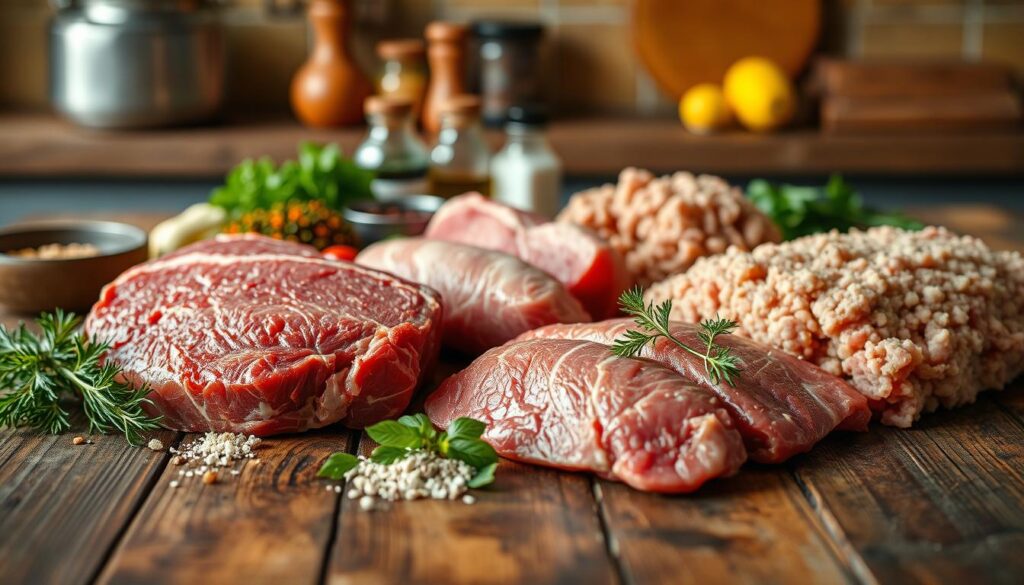Craving a heart-healthy version of classic meatloaf? Reducing sodium in meatloaf doesn’t mean sacrificing flavor. Home cooks can transform this comfort food into a nutritious meal that supports overall wellness. With smart techniques from luyarecipes.com, you’ll discover how to create a meatloaf with low sodium that tastes amazing.
Sodium in meatloaf often comes from processed ingredients and excessive salt. By making simple substitutions and understanding cooking techniques, you can dramatically cut sodium content while keeping every bite delicious. Your taste buds and heart will thank you for these culinary modifications.
Key Takeaways
- Reduce sodium without losing flavor complexity
- Explore heart-healthy cooking alternatives
- Learn strategic ingredient replacements
- Understand health benefits of low-sodium diets
- Master techniques for delicious meatloaf recipes
Understanding the Impact of Sodium in Meatloaf
Meatloaf might seem like a comfort food staple, but the sodium content in meatloaf can pose significant health challenges. Many home cooks unknowingly create dishes packed with hidden sodium that can impact overall wellness.
Health Risks of High Sodium Consumption
When you consume excessive sodium, your body experiences multiple potential health effects. High sodium intake connects directly to increased blood pressure, which strains your cardiovascular system. Kidney function, heart health, and stroke risk can all be negatively impacted by consistently consuming high-sodium meals.
“Your daily food choices play a critical role in managing sodium intake and protecting long-term health.” – Nutritional Health Institute
Recommended Daily Sodium Intake
Nutrition experts recommend adults consume no more than 2,300 milligrams of sodium daily. Most Americans actually consume around 3,400 milligrams, significantly exceeding recommended levels. Understanding the health effects of sodium in meatloaf can help you make smarter dietary decisions.
Common Sources of Sodium in Traditional Meatloaf
Traditional meatloaf recipes often include high-sodium ingredients like processed breadcrumbs, packaged seasonings, and pre-mixed sauces. These components can dramatically increase your sodium intake without adding substantial nutritional value. Awareness is the first step toward creating healthier meal options.
Essential Ingredients for a Heart-Healthy Meatloaf
Creating a heart-healthy meatloaf starts with carefully selecting ingredients that help manage sodium levels in meatloaf. Your goal is reducing sodium in meatloaf without sacrificing flavor or texture. Lean ground meats like turkey or chicken provide an excellent base for a nutritious meal.
“The key to a delicious low-sodium meatloaf is smart ingredient selection.” – Chef Maria Rodriguez
Whole grain breadcrumbs can replace traditional processed options, adding nutritional value while helping control sodium content. Consider using oats or quinoa as alternative binders that boost nutritional profile and maintain moisture.
Fresh herbs and spices play a crucial role in enhancing flavor without relying on salt. Garlic powder, dried thyme, rosemary, and black pepper can create depth and complexity in your meatloaf. Experiment with fresh herbs like parsley or cilantro to add vibrant taste while keeping sodium levels low.
Low-sodium Worcestershire sauce and tomato paste can provide rich flavor without excessive salt. When selecting these ingredients, always check nutrition labels to ensure you’re making the healthiest choice for your heart-conscious meatloaf.
Smart Substitutions to Reduce Sodium Content
Reducing sodium in meatloaf doesn’t mean sacrificing flavor. Creative home cooks can transform traditional recipes into delicious, heart-healthy meals with smart ingredient swaps and innovative techniques.
When crafting a sodium-free meatloaf recipe, your first step is exploring natural flavor enhancers that add depth without salt. Fresh herbs, aromatic vegetables, and bold spices can dramatically improve taste while keeping sodium levels low.
Natural Flavor Enhancers
Experiment with ingredients like roasted garlic, caramelized onions, fresh rosemary, and thyme. These components create rich, complex flavors that mask the absence of salt. Mushrooms and sun-dried tomatoes also provide umami-like taste profiles that make your meatloaf satisfying.
Salt-Free Seasonings and Herbs
Develop your own spice blends using dried herbs, black pepper, paprika, and dried mustard. These seasonings deliver powerful taste without sodium. Nutritional yeast can add a savory note while providing additional nutrients to your sodium-free meatloaf recipe.
Low-Sodium Binding Alternatives
Replace traditional breadcrumbs with ground oats, quinoa, or almond flour. These alternatives not only reduce sodium but also introduce interesting textures and nutritional benefits to your meatloaf. Greek yogurt or egg whites can help maintain moisture without increasing salt content.
“Great cooking is about ingredients and how you combine them.” – Wolfgang Puck
Choosing the Right Meat for Your Low-Sodium Recipe

When creating a meatloaf with low sodium, your meat selection plays a crucial role in controlling sodium content in meatloaf. Lean meats offer an excellent foundation for a healthier recipe that doesn’t compromise on flavor.
Ground turkey and chicken are top choices for reducing sodium levels. These lean poultry options naturally contain less sodium compared to traditional beef or pork. Look for fresh, unprocessed ground meats without added salt solutions or preservatives.
“The quality of your meat determines the health profile of your meatloaf” – Nutrition Experts
Ground chicken breast provides the leanest option, typically containing around 75 calories per 3-ounce serving. Ground turkey can be an equally smart choice, especially when selecting varieties with 93% lean meat content. These proteins allow you to craft a delicious meatloaf while maintaining lower sodium levels.
When shopping, always check meat packaging labels. Opt for fresh, single-ingredient ground meats without sodium-rich additives. This simple step helps you control the sodium content in your meatloaf from the very beginning of your cooking process.
Fresh Herbs and Spices That Pack Flavor Without Salt
Creating a sodium-free meatloaf recipe doesn’t mean sacrificing taste. Fresh herbs and spices are your secret weapons for transforming a bland dish into a flavor-packed meal. Reducing sodium in meatloaf becomes an exciting culinary adventure when you explore the world of aromatic seasonings.
Powerful Herb Combinations for Meatloaf
Some herb combinations can elevate your meatloaf’s flavor profile dramatically. Try mixing fresh rosemary, thyme, and parsley for a robust Mediterranean-inspired taste. Oregano and basil work wonderfully for an Italian-style twist. Sage and marjoram provide a warm, earthy undertone that complements ground meats perfectly.
Smart Herb Storage Techniques
Keeping herbs fresh is crucial for maintaining their potent flavors. Store fresh herbs in the refrigerator wrapped in slightly damp paper towels inside a sealed plastic bag. Alternatively, place them in a glass of water like a bouquet, covering the tops with a loose plastic bag to retain moisture.
Creating Custom Spice Blends
“The right spice blend can transform a simple meatloaf into a gourmet experience.” – Chef Michael Roberts
Experiment with homemade spice blends by combining dried herbs like paprika, garlic powder, onion powder, and black pepper. Grinding whole spices just before use ensures maximum flavor intensity for your sodium-free meatloaf recipe.
Measuring and Monitoring Sodium in Meatloaf
Tracking sodium levels in meatloaf can be challenging, but understanding your recipe’s sodium content is crucial for maintaining a healthy diet. Home cooks can use several practical methods to monitor sodium content effectively.
“Knowledge of sodium intake is the first step toward healthier cooking” – Nutrition Expert
Digital nutrition calculators provide precise measurements for sodium content in meatloaf. Websites like luyarecipes.com offer specialized tools that help you input ingredients and calculate total sodium levels quickly. These digital resources can break down sodium content per serving, giving you complete transparency.
Reading nutrition labels carefully is another key strategy for managing sodium in meatloaf. Pay special attention to packaged ingredients like breadcrumbs, stock, and pre-mixed seasonings. These hidden sources often contribute significant sodium content to your recipe.
Simple tracking techniques can help you reduce sodium levels in meatloaf. Consider using a kitchen scale to measure ingredients precisely and create a consistent baseline for your recipes. Digital apps and nutrition tracking platforms can supplement your efforts by providing comprehensive sodium analysis.
Remember that controlling sodium content doesn’t mean sacrificing flavor. Experimenting with herbs, spices, and alternative seasonings can help you create delicious meatloaf while maintaining lower sodium levels.
Texture Tips for Perfect Low-Sodium Meatloaf
Creating a delicious meatloaf with low sodium doesn’t mean sacrificing texture or flavor. The key lies in understanding how to balance ingredients and moisture to achieve a mouth-watering result that keeps sodium in meatloaf to a minimum.
Your meatloaf’s success starts with selecting the right ingredients and using smart preparation techniques. Professional chefs recommend focusing on three critical aspects: meat-to-binder ratio, moisture control, and overall consistency.
Mastering the Meat-to-Binder Ratio
Getting the perfect balance between meat and binders is crucial for a low-sodium meatloaf. Use breadcrumbs, rolled oats, or crushed crackers sparingly. Aim for about 1/2 cup of binder per pound of meat to maintain a tender, moist texture without adding unnecessary bulk.
Moisture Control Strategies
Preventing dryness is essential when reducing sodium. Incorporate moisture-rich ingredients like grated zucchini, finely chopped mushrooms, or a small amount of low-sodium broth. These additions help keep your meatloaf juicy while maintaining a lean, healthy profile.
Achieving the Ideal Consistency
“The secret to a perfect meatloaf is gentle mixing and careful handling,” says Chef Maria Rodriguez, nutrition expert.
Mix your ingredients gently to avoid compacting the meat, which can result in a tough texture. Use your hands to combine ingredients lightly, stopping as soon as everything is evenly distributed. Rest the mixture for 10-15 minutes before shaping to allow flavors to meld and ingredients to absorb moisture.
Cooking Methods That Enhance Natural Flavors

Crafting a delicious sodium-free meatloaf recipe requires more than just reducing salt. The right cooking method can transform your low-sodium meatloaf into a flavor-packed meal that keeps your taste buds excited and your health in check.
Slow cooking emerges as a game-changing technique for reducing sodium in meatloaf. By using a slow cooker, you’ll lock in moisture and allow herbs and spices to deeply penetrate the meat. This method ensures your meatloaf remains juicy without relying on salt for flavor enhancement.
“The secret to a great low-sodium meatloaf is patience and technique” – Chef Marcus Rodriguez
Broiling offers another excellent approach for sodium-free meatloaf recipes. This high-heat method creates a delightful caramelized exterior that seals in natural juices. Brush your meatloaf with a homemade herb-infused glaze to add depth without extra sodium.
Cast iron skillets can be your best friend when preparing a low-sodium meatloaf. They distribute heat evenly and help develop rich, complex flavors through excellent heat retention. Preheating the skillet before adding your meatloaf can create a delicious, slightly crispy exterior.
Experiment with these cooking methods to discover how you can create a mouthwatering meatloaf that’s both heart-healthy and incredibly tasty.
Making and Storing Low-Sodium Glazes
Creating delicious glazes for your meatloaf doesn’t mean compromising on health. Low-sodium meatloaf can still be packed with incredible flavor through smart glaze preparation. Understanding how to craft and preserve these tasty coatings will elevate your sodium-conscious cooking.
Your homemade glazes can transform a simple sodium in meatloaf recipe into a culinary masterpiece. The key is selecting ingredients that maximize taste while minimizing salt content.
Sugar-Free Glaze Options
When preparing meatloaf with low sodium, consider natural sweeteners like pureed fruits or sugar alternatives. Balsamic vinegar, apple cider, and fresh herbs can create depth without excessive sodium. Experiment with combinations of tomato paste, mustard, and spices to develop rich, complex flavors.
“Great flavor doesn’t require salt – it requires creativity!” – Professional Chef
Preservation Methods
Storing your homemade glazes requires careful technique. Glass containers with tight-sealing lids work best for refrigeration. Most low-sodium glazes maintain quality for 5-7 days when properly stored. Consider freezing extra portions in small batches for future use.
Professional chefs recommend labeling your glazes with preparation dates and ingredients to track freshness and maintain food safety standards for your sodium-conscious meals.
Common Mistakes to Avoid When Reducing Sodium
When exploring the health effects of sodium in meatloaf, many home cooks make critical errors that compromise flavor and nutrition. Understanding these common pitfalls can help you create a delicious low-sodium meatloaf that doesn’t sacrifice taste.
One of the biggest mistakes is under-seasoning your dish. Reducing sodium in meatloaf doesn’t mean eliminating flavor. Instead, focus on using robust herbs and spices that enhance taste without adding salt. Experiment with fresh herbs like thyme, rosemary, and parsley to create depth and complexity in your recipe.
“Flavor is about balance, not just salt content.” – Professional Chef
Another critical error is relying on high-sodium ingredients without realizing their impact. Processed breadcrumbs, pre-mixed seasoning blends, and certain condiments can secretly pack significant sodium content. Check labels carefully and opt for low-sodium alternatives or make your own seasoning mixes.
Neglecting moisture is a common mistake when reducing sodium. Salt helps retain moisture in traditional recipes, so you’ll need to compensate with techniques like adding grated vegetables or using lean ground meats with higher fat content to keep your meatloaf juicy and flavorful.
The health effects of sodium in meatloaf can be significant, so approach your recipe with mindfulness. By avoiding these common pitfalls, you can create a nutritious, delicious meatloaf that supports your dietary goals.
Serving Suggestions and Complementary Side Dishes
Creating the perfect meatloaf with low sodium is just the beginning of a delicious meal. Your sodium-free meatloaf recipe deserves equally flavorful accompaniments that enhance the main dish without adding extra salt.
“Great side dishes transform a simple meatloaf into a memorable dining experience.” – Chef Sarah Martinez
Vegetables make excellent side options for your low-sodium meatloaf. Roasted Brussels sprouts, steamed asparagus, or a colorful mixed vegetable medley can add nutrition and vibrant flavor. Consider preparing these with herbs like rosemary, thyme, or parsley to boost taste without sodium.
Whole grains provide another excellent complement to your sodium-free meatloaf recipe. Quinoa pilaf, brown rice, or barley can offer satisfying texture and additional nutrients. These grains absorb herbs and spices beautifully, creating a delightful side that enhances your main course.
For those seeking a lighter option, consider fresh salads with homemade vinaigrettes. A crisp garden salad or a Mediterranean-inspired mix can provide refreshing contrast to your hearty meatloaf. Experiment with different greens, vegetables, and light dressings to keep your meal interesting and nutritious.
Remember, the key to a fantastic low-sodium meal is creativity and bold flavor combinations. Your meatloaf with low sodium can shine with the right supporting dishes that are both healthy and delicious.
Conclusion
Creating a delicious low-sodium meatloaf is an art that balances health and flavor. By understanding the impact of sodium in meatloaf, you can transform this classic dish into a heart-healthy meal that doesn’t compromise on taste. The health effects of sodium in meatloaf are significant, making it crucial to explore alternative seasoning techniques and ingredient choices.
Your culinary adventure begins with smart ingredient substitutions and creative flavor enhancement strategies. Fresh herbs, spices, and natural seasonings can elevate your meatloaf without relying on salt. By carefully selecting meats, experimenting with moisture control techniques, and developing your own spice blends, you’ll craft a meatloaf that’s both nutritious and delectable.
Ready to dive deeper into low-sodium cooking? Visit luyarecipes.com for an extensive collection of heart-healthy recipes and expert cooking tips. Our resources will guide you through innovative cooking methods, help you understand sodium reduction techniques, and inspire you to create meals that support your wellness goals.
The journey to a healthier meatloaf is about exploration and creativity. Each recipe you adapt is a step toward better nutrition, proving that reducing sodium doesn’t mean sacrificing flavor. Your kitchen is a laboratory of culinary innovation – embrace the challenge and enjoy the delicious results.
FAQ
How much sodium is typically found in traditional meatloaf?
Traditional meatloaf can contain up to 500-800 milligrams of sodium per serving, which is a significant portion of the recommended daily intake of 2,300 milligrams. At luyarecipes.com, we provide recipes that can help you reduce sodium content to under 200 milligrams per serving.
What are the health risks of high sodium in meatloaf?
High sodium intake can lead to serious health issues like high blood pressure, increased risk of heart disease, stroke, and kidney problems. By choosing low-sodium meatloaf options from luyarecipes.com, you can help protect your cardiovascular health while enjoying a delicious meal.
How can I make my meatloaf flavorful without using salt?
You can enhance flavor using fresh herbs like thyme, rosemary, and parsley, along with low-sodium seasonings such as garlic powder, black pepper, and dried herbs. Luyarecipes.com offers numerous salt-free seasoning blend recommendations to keep your meatloaf delicious and heart-healthy.
What are the best meat options for low-sodium meatloaf?
Lean ground turkey, chicken, or grass-fed beef with low sodium content are excellent choices. Look for meats with minimal added sodium and avoid pre-seasoned or processed ground meats. Luyarecipes.com provides detailed guides on selecting the best meats for low-sodium recipes.
Can I use breadcrumbs in a low-sodium meatloaf?
Yes, but choose low-sodium breadcrumbs or alternatives like oats, quinoa, or ground nuts. Avoid pre-seasoned breadcrumbs, which often contain high sodium levels. Our experts at luyarecipes.com recommend making your own breadcrumbs to control sodium content.
How do I measure sodium content in my homemade meatloaf?
Check nutrition labels of individual ingredients, use online sodium calculators, or consult resources like luyarecipes.com that provide comprehensive nutritional breakdowns. Tracking each ingredient helps you accurately monitor and reduce sodium intake.
Are there salt-free condiments I can use in meatloaf?
Absolutely! Consider using no-salt-added tomato sauce, homemade herb-infused ketchup, or low-sodium Worcestershire sauce. Luyarecipes.com offers multiple recipes for creating flavorful, sodium-free condiments to enhance your meatloaf.
What binding alternatives can I use to replace high-sodium ingredients?
Try using egg whites, mashed vegetables like zucchini or cauliflower, or ground flaxseed as low-sodium binding agents. These alternatives not only reduce sodium but also add nutritional value to your meatloaf. Check out our innovative recipes at luyarecipes.com.









